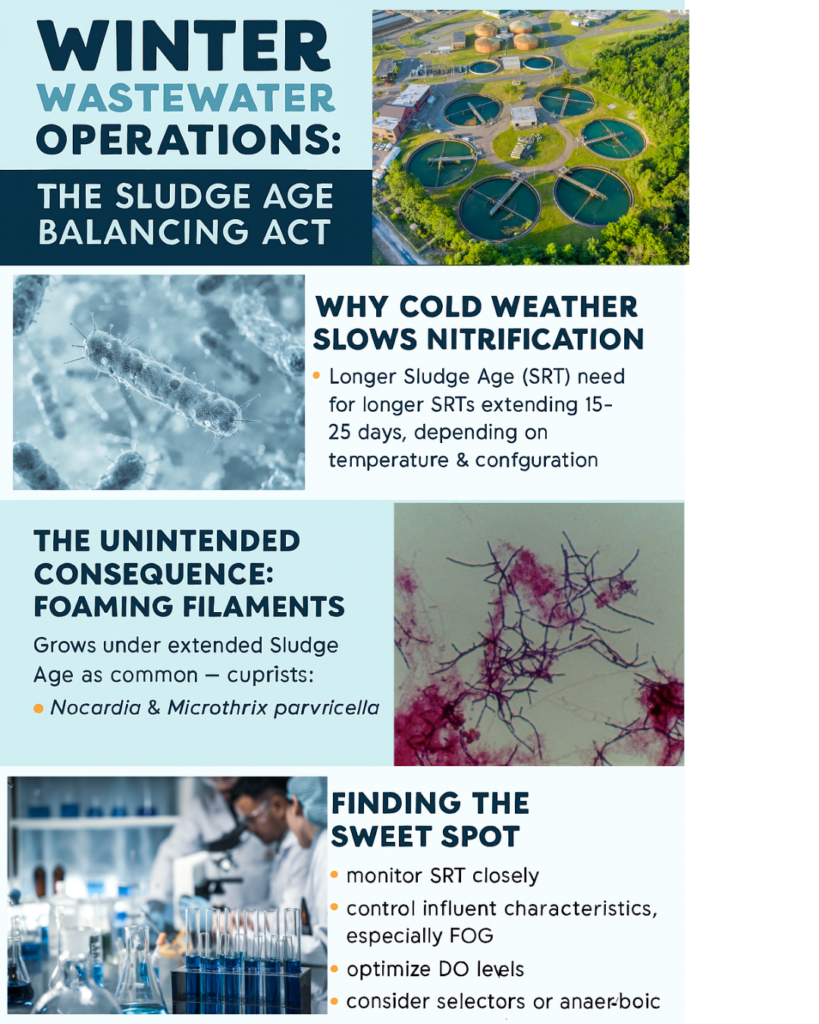
As temperatures drop, wastewater treatment plants face a seasonal challenge that’s as subtle as it is critical: maintaining the delicate balance between nitrifying bacteria and filamentous organisms. Winter operations demand longer sludge ages to support ammonia-oxidizing bacteria (AOB) and nitrite-oxidizing bacteria (NOB), but this strategy can inadvertently fuel the rise of foaming filaments. Let’s unpack this microbial tug-of-war and explore how operators can stay ahead of it.
Why Cold Weather Slows Nitrification
Nitrification is a temperature-sensitive process. AOB and NOB are slow growers even in ideal conditions, and their activity drops significantly in cold weather. To compensate:
- Sludge age (SRT) must be increased to retain these slow-growing microbes (preventing washout).
- Typical winter SRTs may extend to 15–25 days or more, depending on temperature and system configuration.
- Low temperatures also reduce microbial metabolism, meaning longer retention is needed to achieve the same level of ammonia and nitrite conversion.
This strategy helps preserve nitrification capacity, but it’s not without trade-offs.
The Primary Unintended Consequence: Foaming Filaments
Longer sludge ages create a more stable environment — not just for nitrifiers, but also for certain filamentous bacteria that thrive under low F/M (food-to-microorganism) conditions. The usual suspects?
- Nocardia and Microthrix parvicella are notorious for causing stable, persistent foam.
- These filaments flourish in high SRT systems, especially when coupled with:
- High lipid content in influent
- Low DO zones
- Surface aeration
Foaming isn’t just a nuisance — it can interfere with oxygen transfer, reduce settling efficiency, and pose safety risks for operators.
Finding the Sweet Spot
Balancing sludge age in winter is a strategic dance. Here are some tips to keep both nitrifiers and filaments in check:
- Monitor SRT closely and adjust incrementally. Avoid overshooting beyond what’s needed for nitrification.
- Control influent characteristics, especially fats, oils, and grease (FOG), which feed foaming filaments.
- Optimize DO levels to discourage low-oxygen filament growth while supporting nitrifiers.
- Consider selectors or anaerobic zones to suppress filamentous bacteria through competitive exclusion.
- Use molecular testing & microscopic examination to track microbial populations and adjust SRT based on test findings.
Wrapping Up
Winter operations demand a nuanced approach to sludge age management. While longer SRTs are essential for maintaining AOB and NOB populations, they can also tip the scales toward filamentous foaming if left unchecked. By understanding the microbial dynamics and implementing targeted controls, operators can keep their systems running smoothly — even when the mercury drops.

Helpful, much appreciated.